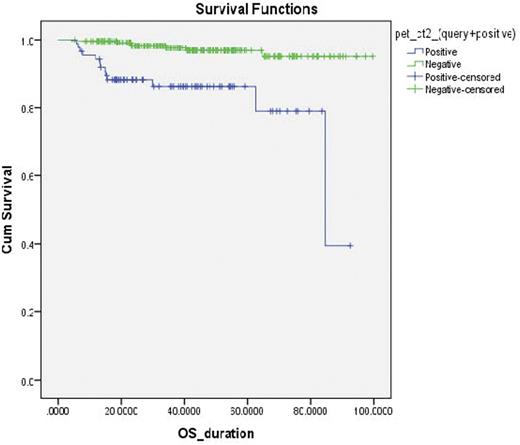Abstract
Rationale and aim of the study: This is a retrospective, single center study was done to assess the prognostic role of 'interim' positron emission tomography (PET) performed during treatment of advanced stages HL with doxorubicin, bleomycin, vinblastine and dacarbazine (ABVD) in pediatric patients.
Patients and methods: Three hundred and eighty one patients with newly diagnosed Hodgkin lymphoma were enrolled. One hundred sixty five patients with early unfavorable and 216 with advanced-stage disease were treated with ABVD ± involved-field radiotherapy (IFR). PET scan was performed at baseline and after two cycles of chemotherapy. Treatment was not changed according to the results of the interim scan. PET scans reports was used using the Deauville five-point scale, blinded to treatment outcome.
Results:Eighty-seven scans out of 336 were scored as positive (17.3%) and 249 (82.7%) as negative. The 5- years overall survival (OS) was 94% (95% Confidence Interval (CI) :91.5 Ð 96.6) for the whole study population, 86.2% (95% CI :78.3 - 94) for patients with interim positive scans and 97% (95% CI:94.2 - 99.3) for patients with interim negative scans (P<0.0001) [Figure:1].
The 5-year Event-free survival (EFS) rate was 80% (95% CI :74.3 Ð 84.4) for the whole study population, 63.2% (95% CI :48.6 Ð 77.4) for patients with interim positive scans and 82.6% (95% CI :76.3 Ð 88.8) for patients with interim negative scans (P<0.0001) [Figure:2].
In conclusion: The prognostic role and validity of using the interim PET scan response have been confirmed to be strongly related to treatment outcome by the present study. These results confirm that ABVD with or without IFR is an adequate treatment for more than 70% of pediatrics patients in advanced stages HL.
No relevant conflicts of interest to declare.
Author notes
Asterisk with author names denotes non-ASH members.



This feature is available to Subscribers Only
Sign In or Create an Account Close Modal